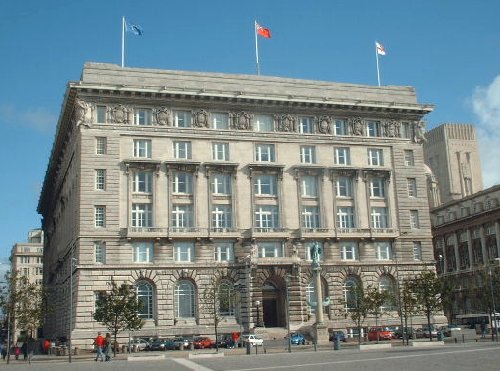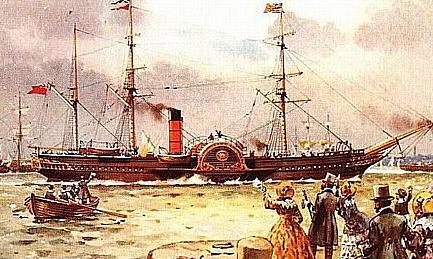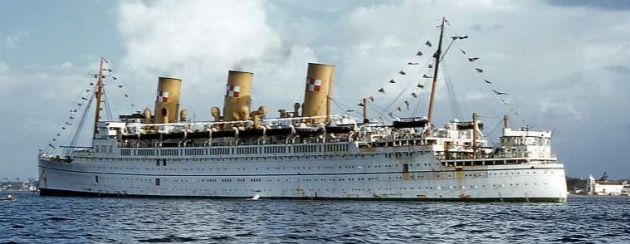Cunard Line Plans 175th Anniversary Celebrations At Liverpool
21/11/2013 2 Comments

The Cunard Building, recently purchased by the City of Liverpool. The lower levels will form the basis of a new cruise terminal for both embarkations and arrivals
Cunard Line last week announced two special events in 2015 in its founding city of Liverpool, to mark the line’s 175th anniversary in 2015.

RMS Queen Mary 2 in Liverpool
To start with, all three Queens, the 148,528-ton Queen Mary 2, 90,901-ton Queen Elizabeth and 90,049-ton Queen Victoria, will rendezvous for the first time on the Mersey on May 25. Plans call for the Queen Mary 2 to arrive at Liverpool Cruise Terminal on May 24 for an overnight stay. On the morning of the 25th she will be joined in the river by her fleetmates Queen Elizabeth and Queen Victoria.
The three ships will all stand in close to the famous Cunard Building on the Pier Head, which served as Cunard Line’s headquarters for the half century between 1917 and 1967. When the Queen Mary 2 casts off from the famous Prince’s Landing Stage, over which passed so many migrants as well as First Class passengers, her place will be taken by one of her fleetmates while the other will remain at anchor to be served by tenders.
Then, on July 4, the Queen Mary 2 will sail from Liverpool to recreate the first Transatlantic crossing of the 1,154-ton Britannia from Liverpool to Halifax (see painting left), which she did in 12 days and 10 hours, and on to Boston. Although New York was not added to the route until 1847, it is now the Queen Mary 2′s base port so she will proceed there after Boston – and yes she has 128 times the tonnage of the Britannia of 1840.
July 4, 2015, will mark 175 years to the day after the Britannia first departed Liverpool on her maiden Transatlantic voyage under the new mail contract. And for the first time in over fifty years, it will be possible for passengers to board a Cunard ship in Liverpool and sail for the United States
When Cunard established the first scheduled passenger and mail steamship service across the Atlantic, the first sailing actually took place on May 16, 1840, when the 648-ton Unicorn left Liverpool with 51 passengers, six weeks ahead of the Britannia.
“Hazard’s United States Commercial & Statistical Register” said of the Unicorn: “We learn from Capt Douglas that the Unicorn left Liverpool on the 16th of May, and arrived at Halifax on the first instant, about 10 am, and remained there until 11 o’clock pm. She brought out 27 cabin passengers for Halifax and 24 for Boston; and files of London papers to the 15th of May; Liverpool of the 16th, and Paris of the 13th. The Unicorn is a neatly built and gallant steamer of about 700 tons burthen, and a very fast sailer. The cabin accommodations are of a very superior character, and that passengers state, that although they had headwinds during the greater part of the passage, yet they have enjoyed the trip exceedingly.”
The Unicorn was sent out as a feeder ship for the Canadian mails between Quebec and Pictou NS, with connection made to Halifax by stagecoach. She arrived at Quebec on June 29, ready to take up her new duties, carrying the Canadian mails to connect with the Britannia’s first sailing from Halifax and returning with the latest mails from England.
This first Transatlantic voyage by the Unicorn is often forgotten as it did not actually take place within the mail contract but was made in order to position the ship to North America. Nevertheless, it was a test voyage for the four new ships then being built for Cunard.
The Unicorn’s master, Capt Walter Douglas, had commanded the 605-ton St Lawrence steamer Canada, built at Montreal in 1832, and had surveyed the St Lawrence River for the Canadian Government. Occasionally, between voyages, he took the Unicorn to the Saguenay River, thus becoming one of the first ships to engage in that trade.
“Fisher’s Colonial Magazine” made note of this in July 1843: “It is singular, that it has remained for the present age first to explore the river Saguenay, which, rising in the bosoms of the desolate mountains of Labrador, after a course of 500 miles, falls into the St Lawrence, about 170 miles below Quebec. Captain Douglas, of the Unicorn, who first explored it, found its current full and rapid, its average breadth a mile, its depth often exceeding 200 feet, and its banks in one place 800 or 1,000 feet high, and consisting of perpendicular or overhanging cliffs of lime; on such a huge scale does nature work in those solitudes.”
Now, nearly every cruise ship that enters the St Lawrence makes the detour to the Saguenay to pass by Capes Trinity and Eternity and to observe the whales feeding at the mouth of the Saguenay where it flows into the St Lawrence. As Cunard did not start its own direct St Lawrence service until 1911, most are not aware of this early St Lawrence feeder service and Cunard’s original participation in the Saguenay cruise trade.
But back to modern times, when the Queen Elizabeth 2 first arrived on the Mersey in 1990 to celebrate the line’s 150th Anniversary more than a million spectators turned out to see her and the fifteen visits since by Cunard Queens have always received warm and enthusiastic welcomes. Next year, for example, in another celebration, the Queen Victoria will sail into Liverpool on May 29, 2014, for an overnight stay to commemorate the hundredth anniversary of the maiden voyage of the 45,647-ton Aquitania, then the largest ocean liner in the world, from Liverpool to New York on May 30, 1914 (see painting above).
The City of Liverpool has meanwhile bought the Cunard Building for use as council offices and the original First Class reception areas in the lower levels will be brought back into service as a cruise reception and baggage area or future callers, something that will add a real sense of authenticity for Liverpool-boarding passengers.
For Cunard Line World Cruise and Transatlantic bookings please consult The Cruise People Ltd in London on 020 7723 2450 or e-mail cruise@cruisepeople.co.uk. In North America, call 1-800-961-5536 or e-mail cruise@thecruisepeople.ca.



 THE CRUISE EXAMINER at
THE CRUISE EXAMINER at 